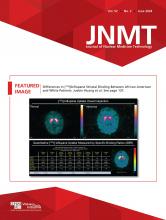Assessment of the kidney’s vascular flow is a vital component of the renal scan; however, achieving perfect positioning for a 99mTc-mercaptoacetyltriglycine (99mTc-MAG3) renal scan can be an uphill struggle, even with a recent CT scan to refer to. Typically, the kidneys are located bilaterally and posteriorly near the upper lumbar vertebrae, with the left kidney slightly more superior than the right (Fig. 1). The quick pace of renal arterial flow leaves little room to readjust positioning should the kidneys not be in the field of view (1). Typically, the aorta is visible within 1 s after injection, and the kidneys can be viewed within 5–6 s. Maximal kidney activity is usually seen within 30–60 s after injection. Thus, it is essential to have correct positioning from the start of the scan. Too often, technologists say, “As long as the kidneys are in the field of view, we are good.” However, interpreting physicians favor having the kidneys and bladder in all images to assess image data accurately.
Kidney location related to spine. Kidneys are usually located bilaterally and posteriorly near upper lumbar vertebrae.
CLINICAL INDICATIONS
Renal scans are performed for various indications, including diagnosis of renovascular hypertension, pyelonephritis, mass, or trauma (2). One of the most common indications is diagnosing obstructive uropathy, which requires having the bladder in the field of view for the entire study. A full bladder, caused by failure to void before the examination or a poorly draining Foley catheter, can cause delayed urinary tract emptying, mimicking ureter obstruction (2). The Foley catheter should be positioned to drain freely during the procedure to allow proper upper tract or renal collecting system drainage. Poor Foley drainage during the procedure, as demonstrated by the filling of the bladder, should be immediately resolved by manipulation of the tubing to improve drainage.
Guessing where the kidneys and bladder are located can be difficult. Use of a positioning dose can ensure that the kidneys and bladder are always in the field of view before the acquisition begins.
POSITIONING DOSE
To prepare the positioning dose, draw approximately 5%–10% of the patient dose (usually 1 drop) in a 3-mL syringe, and then fill with 0.9% saline to a volume of 3 mL. The typical dose for a renal scan is 370 MBq (10 mCi) of 99mTc-MAG3. Between 18.5 and 37 MBq (0.5–1 mCi) of 99mTc-MAG3 are adequate for the positioning dose.
Position the patient supine on the imaging table with the detector in the posterior position to take advantage of the standard posterior location of the kidneys, and include the kidneys and bladder in the field of view. Obtain intravenous access, and administer the positioning dose, followed by a flushing dose of 10–30 mL of 0.9% saline (via a syringe or saline bag) to ensure that the full positioning dose has been administered. If necessary, reposition the patient using the persistence oscilloscope (P-scope) to include the kidneys and bladder in the field of view. Setting the P-scope refresh rate to “none” may be necessary to visualize the kidneys. If the bladder is not easily identified, position the kidneys at the top of the field of view to ensure visibility of the bladder in later images.
Once the patient is correctly positioned to include the kidneys and bladder in the field of view, administer the remaining 99mTc-MAG3 dose and acquire the renal flow and dynamic images. Because the positioning dose is a fraction of the total patient dose, it will not be seen on the initial flow images (Fig. 2).
Renal flow using positioning dose. First frame in part A demonstrates flow of renal scan, where very faint kidneys can be seen from positioning dose. Arrow in frame 16 shows blush of bladder starting to appear. Part B proves how using positioning dose can acquire high-quality images where kidneys and bladder are within field of view.
RENAL TRANSPLANT PATIENT POSITIONING
For renal transplant patients, position the patient supine with the camera in the anterior position over the iliac fossa. Frequently, the transplanted kidney is near or overlies the bladder. When positioning renal transplant patients, the goal is to position the atrophied native kidney or kidneys and the transplanted kidney in the field of view, which helps in the comparison of native kidney function and transplanted kidney function. Anterior and posterior images may be necessary for this comparison.
CONCLUSION
Positioning the kidneys and bladder in the field of view can be difficult. Correct positioning and visualization of the kidneys, ureters, and bladder is critical for suspected outflow obstruction when a full bladder or ureter obstruction can cause delayed emptying. Using a positioning dose can help produce perfect images every time.









